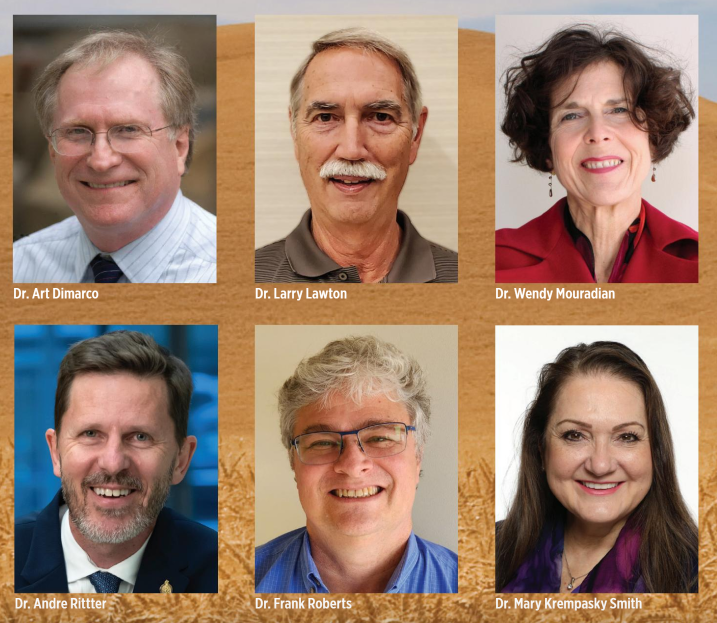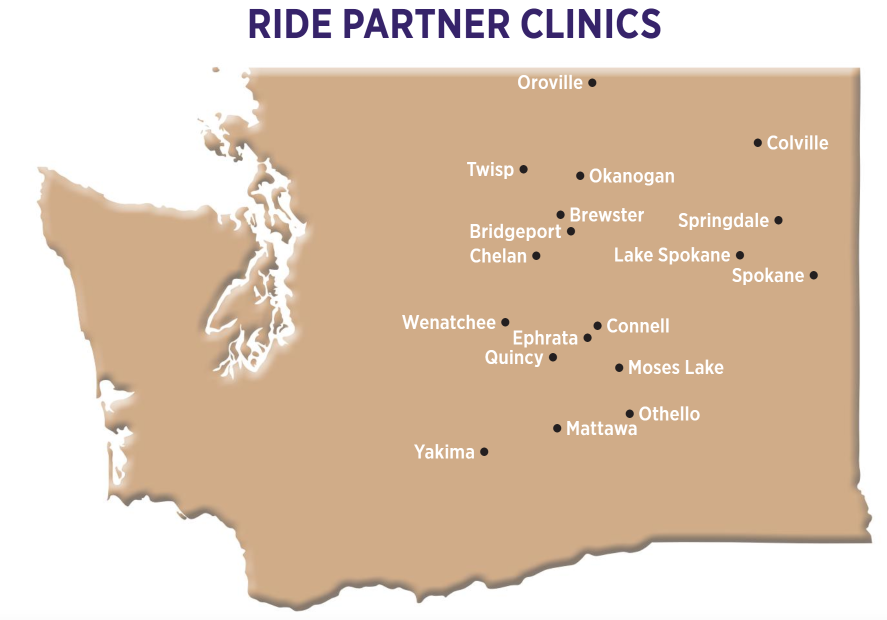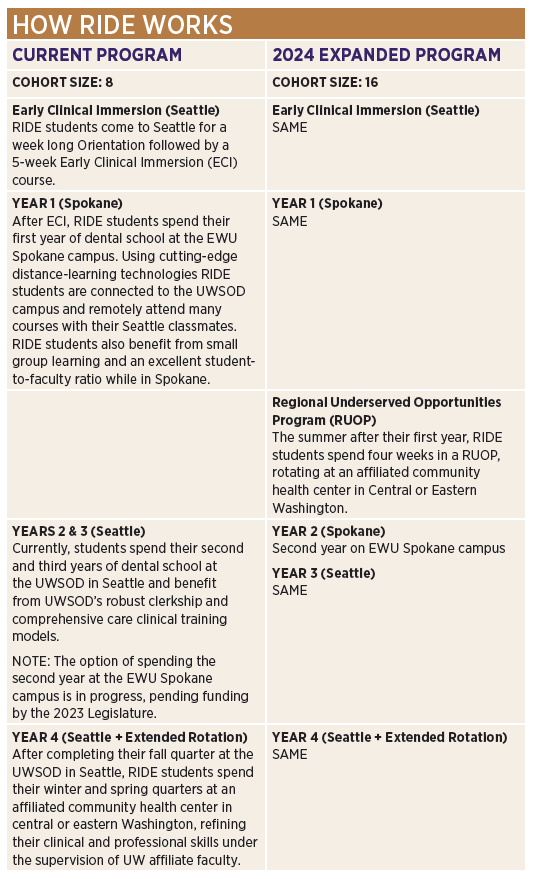It's been called many things: Groundbreaking. Revolutionary. Award-winning. Perhaps most importantly, it's effective. Ask anyone affiliated with the University of Washington School of Dentistry's Regional Initiatives in Dental Education (RIDE) program and they will tell you: RIDE works. Learn more about the program and its plans for expansion in the WSDA News Issue 1 cover story.

QUICK BITES
- The Regional Initiatives in Dental Education or RIDE program is an award-winning and internationally recognized dental education model for successfully training and placing dentists in rural and underserved areas of the state. The program launched its first cohort in 2008.
- More than 70 percent of RIDE graduates go on to practice in rural and underserved areas of Washington and the region.
- RIDE relies on partnerships established with affiliated community health centers across central and eastern Washington.
- This legislative cycle WSDA is supporting the UWSOD budget request for $4.3 million to expand the program and double the number of students from 8 to 16. It would also fund enhancements to the dental simulation lab at the EWU Riverpoint Campus, allowing second-year students to remain at EWU Spokane.
|
It’s been called many things: Groundbreaking. Revolutionary. Award-winning.
Perhaps most importantly, it’s effective.
Ask anyone affiliated with the University of Washington School of Dentistry’s Regional Initiatives in Dental Education (RIDE) program and they will tell you: RIDE works.
The premise was simple: Educate dental students in eastern Washington, provide them with prolonged exposure to the region’s communities, and create a pipeline for addressing access to care issues.
But RIDE did more than just meet expectations — for the university, its graduates and the communities it serves. For the last 15 years, RIDE’s innovative approach to undergraduate dental education has transformed the training of undergraduate dental students and simultaneously enhanced access to care in rural and underserved communities in the eastern half of the state.
‘A VERY SPECIAL PROGRAM’
The RIDE program was fueled by two parallel challenges: limited physical capacity on the University of Washington’s main campus to expand its existing dental school footprint and the need to address the scarcity of dentists in rural and underserved areas of central and eastern Washington.
One glance at the dentist-to-population ratio reveals the need. In King County, there’s approximately one dentist for every 948 people. But in Pend Oreille County along the Washington-Idaho border, it drops to one dentist per 12,300. Programs that address those needs, while also setting young professionals up for success, are key to filling those care needs.
The resulting RIDE program has successfully — and consistently — produced graduates who are both professionally and personally prepared to serve as dentists and leaders in their communities. With a 70 percent placement success rate, RIDE has drawn acclaim and its expansion is a priority for the UW in this year’s legislative cycle.
Dr. André Ritter, who became dean of the UW School of Dentistry last September, says the program is an important reflection on the mission of the school.
“It’s amazing to see the energy that the students project and the positivity of the faculty as well. It’s a very special program,” he said. “To me, it’s refreshing to come to a university and to go outside of the ivory tower walls. As UW President Ana Mari Cauce often notes, we are not so much the University OF Washington as we are the University FOR Washington,” he said.
“We are here not just to serve our students, but to serve communities across the region.”

AN OPPORTUNITY TO INNOVATE
As with many things in the Northwest, the innovation of RIDE has its roots in the region’s adventurous efforts to serve remote communities.
In the 1970s, the UW School of Medicine established what’s now widely known as WWAMI, short for the five participating states (Washington, Wyoming, Alaska, Montana and Idaho). To address access to medical care in rural and underserved areas, the WWAMI model recruits students who agree to return to their home states and practice in them upon graduation.
Dr. Wendy Mouradian, now professor emeritus of pediatric dentistry and a strategic advisor for RIDE expansion, saw an opportunity in applying the success of WWAMI to the UW’s dental school.
As the program’s founder and visionary force behind RIDE, Mouradian is credited with not only developing the dental school model, but also attracting faculty and leveraging what was then groundbreaking distance learning technology.
“The School of Medicine has also learned that there is a huge reciprocal benefit of community good will and continuing education that develops from inviting community practitioners into the educational process,” said Dr. Mouradian in the UW Dental Alumni News during the program’s early years. “And medical students do in fact return to these regions at higher rates than the national average.”
The same would be true of her program, RIDE. In 2008, the first cohort of students began taking classes locally and via videoconference at the Eastern Washington University (EWU) Riverpoint Campus in Spokane.
By 2014, Mouradian transitioned leadership of the program to Dr. Frank Roberts, who now serves as RIDE director. Roberts has maintained the program’s focus on providing the same high-level of curriculum and technology for students in Spokane as those at the Seattle campus.
Finding local dentists who would serve as preceptors and faculty was also a big part of the successful launch — and continued growth — of RIDE. Roberts said the Spokane District Dental Society played a key role in the development of RIDE as early supporters of the program. Dr. Jim Sledge of Spokane was the first Regional Clinical Director, and worked with all of the community dentists to get the program off the ground.
“His positive attitude helped assure that the Eastern Washington dentists and community health centers were enthusiastic about coming on board with the SOD and RIDE program,” added Roberts.
“Spokane is a real can-do place — they started the [Access to Baby and Child Dentistry] program — and RIDE was the next idea.”
A RIDE LIKE NO OTHER
One of the RIDE program’s hallmarks remains a fast-paced clinical experience.
Upon acceptance, eight dental students form their class’s RIDE cohort. From there, they begin orientation in Seattle, meet the rest of their dental classmates and participate in an early clinical immersion course on the UW Seattle campus.
Next, they spend their first year at the EWU Riverpoint Campus in Spokane. RIDE students take the same dental classes as their peers in Seattle — sometimes in person and sometimes using remote learning technology (something RIDE students did long before COVID). Students enrolled in RIDE also take general anatomy classes alongside EWU dental hygiene and UW WWAMI medical students, creating an early interdisciplinary connection.
That’s where the RIDE experience diverges from a traditional UWSOD program.
The summer after their first year, the RIDE cohort participates in a four-week RUOP (rural/underserved opportunities program) rotation where they have the opportunity to serve as dental assistants under two or three dental preceptors at a community health clinic located in central and eastern Washington. This includes such communities as Chelan, Colville, Lake Spokane, Moses Lake, Okanogan, Othello, Spokane and Wenatchee, and Yakima. There are also satellite clinics in Brewster, Bridgeport, Connell, Ephrata, Mattawa, Oroville, Springdale, and Twisp.
Students in community clinics work under the oversight of two or three dental preceptors, just as they would faculty supervision at the UWSOD. RIDE students work at a quicker pace — seeing six to eight patients a day compared to two or three in Seattle.
“By immersing the students in these communities, they get to know and understand what the needs are, and those are wonderful practice opportunities,” said Dr. Roberts. “We’ve also had several students apply who are from these rural areas who do know the shortcoming of the communities. Nobody knows the need better than they do.”
After spending their second, third year and the start of their fourth back in Seattle with the rest of their class, RIDE students return to the communities where they served their RUOP rotations for a five-month clinical rotation before graduating — only this time they return as full practitioners.
The RIDE program is a separate application process from the Seattle UWSOD program — students have to request it. As a result, it’s also changing the kind of student who enters the UW dental program.
“I think, as we’ve looked at the RIDE program, it might be the most diverse part of the whole school,” said Dr. Art DiMarco, EWU RIDE director. “I’ve had applicants who say, ‘If I don’t get into RIDE, I don’t want to come.’”
DiMarco believes the design of the program also helps prepare RIDE students for their launch into practicing dentistry, noting that RIDE graduates have a greater depth of clinical experience by the time they graduate.
“I remember our first accreditation years ago, walking to the final meeting, having someone remark, ‘This is the way it should be done — you’re doing it the right way!’”

MORE LIKE A FAMILY
Dr. Larry Lawton knows all too well what it’s like to practice in a small, rural community. Lawton, who serves as an affiliate professor of oral medicine in the RIDE program, grew up in the small eastern Washington town of Washtucna in Adams County. Eventually he built a practice in Rosalia and now resides in Mead, just north of Spokane.
“The program works really well, in part due to the fact that we have good contact between faculty and students. As a result, the students that come out of it I think are better prepared to become new dentists,” he said. “It’s an intense program — and they do well because they want to be there and we want them to succeed. My RIDE students can practice anywhere against anybody.”
For some students, a rural environment may be more enticing than entering into a private practice in an urban or even suburban setting. It can also be financially advantageous.
Dr. Mary Krempasky Smith, RIDE regional clinical director and faculty member, says dentists in rural practices are able to repay their loans faster — and retire earlier -- than their urban counterparts. That’s a significant advantage for today’s graduates facing hundreds of thousands of dollars in student debt.
“Some programs will assist professionals who come into certain areas, even build out their professional building for you. You can pay off your loans faster and the cost to do business is lower — you have more discretionary dollars to reduce your debt,” she said.
“It’s a different type of practice. But among the providers I see — I notice how happy they are. And the student who go back to those areas are pleased — that’s a big deal.”
Sending students into rural areas also requires specialized training beyond dentistry. In the RIDE program, students not only learn the practice of dentistry, but also the leadership and community engagement skills necessary to settle and be successful in their communities.
Dr. Roberts notes that in many towns, the local pharmacist may be the one medical provider who consistently meets with every patient, regardless of who the provider may be. Forging those professional working relationships can be crucial for RIDE grads.
“Pharmacists are nice for community dentists to get to know and have working relationships with — patients come to them,” he said. “The dentists that are going to practice in rural and underserved areas need more training, not less. We make sure they get extra training so they can be successful knowing what they can and can’t do — when to refer. We want them to build a network of experts they can talk to, including specialists for challenging cases — endodontists, oral surgeons, experts in oral medicine,” he said.
“Part of what we do is connect them with their rural environments. It can be isolating,” added Roberts. “It’s not just giving them training on how to do things, but connecting them with people who can serve as resources for them. “
ADDRESSING ACCESS TO CARE
Even before the pandemic, access to care issues were a concern in every corner of the state. RIDE continues to address this need by consistently delivering quality providers into the heart of communities most in need. Eventually, these practitioners settle in Moses Lake, Connell, Ephrata or Twisp, raise their families there and become part of the community.
As the RIDE Regional Clinic Director, Dr. Smith views the program as a strategic win for everyone.
“We are meeting a need we have not been able to meet. It also helps in the cost of providing care at the university. By going into community centers, we are able to do it in a standing clinic, utilizing staff there and patients that may have been waiting,” she said. “Taking the treatment to the patients who need it rather than patients having to make their way to us — that’s the future of dental education. Addressing needs where the patients are rather than finding the solution at the dental school. It’s just a different model.”
Dean Ritter recognizes the power of a program like RIDE to be a change-agent for both undergraduate dental education and access to care issues.
“For way too long, we have been relatively passive in providing the best dental education on campus and waiting for patients to come to our doors. And I think what RIDE does is recognizes that access to care is a huge barrier, and provides a structure for us to have a program in those areas of need,” he said. “I think the record shows this has been successful in not only oral health care provided — especially in the fourth year, but more importantly after they graduate.”
While RIDE remains largely focused on solving the care needs in central and eastern Washington, there’s no denying that communities in western Washington would also greatly benefit from a RIDE initiative. Ritter acknowledges the school continues to look for expansion opportunities in all areas of the state.
“We are constantly looking for partner organizations for students to go out and have training in a multitude of sites,” he said. “For this program to be successful, there has to be good consistency for students clinically and didactically, and to have the same caliber of instructors, to give students a high level of education.”
PROGRAM EXPANSION
WSDA Executive Director Bracken Killpack says the RIDE program has repeatedly demonstrated success for dentists who want to practice in rural areas, and addresses all of the concerns he’s seen with the dental school undergraduate experience.
“I believe the RIDE program should be the care delivery model for all undergraduate dental education, embedding students in communities outside of Seattle as much as possible,” he said. “Students in RIDE have more patient encounters, which helps ensure their success upon graduation. Expanding this program represents a positive next step for the dental school.”
This year may be an important turning point for RIDE. The university and the School of Dentistry are jointly making a $4.3 million appropriation request of the Legislature; it is on the UW’s legislative priority list, and is strongly supported by the WSDA.
Dr. Smith reiterated the challenge of trying to build new facilities on the UW campus in Seattle — and the potential costs associated with any of that construction. Asking patients to travel to a highly congested area like the UW Seattle campus, compounded by limited parking availability, also limits access to care.
“This is a way to increase the size of dental school without having to increase footprint of the UW structurally,” said Dr. Smith. “It’s far more affordable for the state, and we have the building available to us in Spokane, so it’s a lower cost. To try to build on UW campus is space and cost prohibitive,” she added.
The budget request would be utilized to support expansion of the program, adding eight more students to each new cohort for a total of 16 and would allow students to stay in Spokane on the EWU campus for a second year of dental school training.
Additionally, the funding would fund a state-of-the-art simulation lab at Riverpoint campus and allow for the addition of faculty and staff to help support the growing cohort of students. The lab upgrade would free up more space benefitting students in both the RIDE and dental hygiene programs according to Dr. DiMarco, who also serves as a professor of dental hygiene at EWU.
RIDE program expansion has been included in Gov. Inslee’s budget; both Killpack and Dean Ritter, are optimistic the request will be funded.
“This is a different model for oral health education and I hope we can continue to strengthen and grow the program,” said Dr. Ritter. “When I went to dental school over 30 years ago, the main motivation for me and my classmates was to graduate and practice dentistry in an urban setting. That is still a viable model today for many graduates, but there is no question that to meet the access to care challenges our region faces we need programs such as RIDE,” he said.
“At the UW, students have much more of a community outreach focus. I think this is a reflection of some of the changes happening in dentistry, and some of the changes we’re seeing in health care in general.”

GLIMPSING INTO THE FUTURE
Increasingly, RIDE is looking like a model for the future of dental education not just in Washington and the region but across the country — even around the globe.
In 2017, RIDE garnered the prestigious American Dental Education Association’s William J. Gies Award for Vision by an Academic Dental Institution.
“We want to recognize that RIDE is an award-winning program, and we hope we continue to build on that trajectory,” said Dr. Ritter.
“Expansion means we are doing more for oral health care in rural Washington and in underserved communities.”
This article originally appeared in 2023 Issue 1 of the WSDA News magazine.